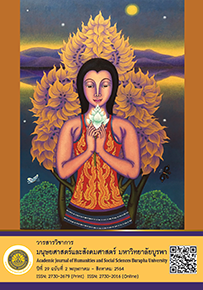Thai Language Usage Errors of Korean Masters of Ceremonies in Travel Documentary Television Shows
Main Article Content
Abstract
The purpose of this research was to explore the types of Thai language usage errors made by Korean masters of ceremonies in television travel documentary television shows. The data were six television travel documentary television shows broadcast in A.D. 2016. The research results were presented in descriptive analysis. The findings revealed that there were three types of Thai language usage errors. The first type was the errors in pronunciation, namely: the pronunciation of intonations, vowels, and consonants, respectively. The second type was the errors in word usage: wrong use of nouns such as classifier, and words with wrong meanings, respectively. The third type was the errors in grammar. For example, unnecessary use of words, deletion of necessary words, and wrong order of words, respectively. The analysis of these three types of errors revealed that the major factors of errors arose from L1 interference and deficiency of language developmental errors of the Korean masters of ceremonies.
Downloads
Article Details
บทความทุกบทความเป็นลิขสิทธิ์ของวารสารวิชาการมนุษยศาสตร์และสังคมศาสตร์ มหาวิทยาลัยบูรพาเท่านั้น
References
เขมนิจ จามิกรณ์, เอกสิทธิ์ สนามทอง, อิทธิพัทธ์ สุวทันพรกูล และดวงเดือน จันทร์เจริญ. (2563). แนวทางการพัฒนาสมรรถนะผู้ด้าเนินรายการโทรทัศน์ระดับมืออาชีพในประเทศไทย. วารสารวิจัยและพัฒนา มหาวิทยาลัยราชภัฏสวนสุนันทา, 12(2), 105-115.
จินดารัตน์ ธรรมรงวุทย์. (2553). ข้อบกพร่องเชิงวัจนปฏิบัติศาสตร์ในการสื่อสารระหว่างวัฒนธรรม: กรณีศึกษาการใช้ภาษาไทยของผู้พูดชาวอเมริกันและชาวจีน. วิทยานิพนธ์ศิลปศาสตรมหาบัณฑิต, สาขาวิชาภาษาศาสตร์เพื่อการสื่อสาร, คณะศิลปศาสตร์, มหาวิทยาลัยธรรมศาสตร์.
ซูเคียง แบ. (2538). การวิเคราะห์และเปรียบเทียบระบบหน่วยเสียงภาษาไทยกับภาษาเกาหลีเพื่อการสอนภาษาไทยในฐานะภาษาต่างประเทศแก่ผู้เรียนที่เป็นคนเกาหลี. วิทยานิพนธ์ศึกษาศาสตรมหาบัณฑิต, สาขาวิชาการสอนภาษาไทย, บัณฑิตวิทยาลัย, มหาวิทยาลัยเชียงใหม่.
ฌองส์ ฮวัน ซึง. (2536). การวิเคราะห์เปรียบเทียบระบบโครงสร้างภาษาไทยและภาษาเกาหลี. วิทยานิพนธ์ศิลปศาสตรมหาบัณฑิต, สาขาวิชาภาษาไทย (สายภาษา), คณะมนุษยศาสตร์และสังคมศาสตร์, มหาวิทยาลัยสงขลานครินทร์.
ฌองส์ ฮวัน ซึง. (2541). ภาษาเกาหลีเบื้องต้น. คยองกี, เกาหลี: ซัมจิซา.
ณัชชา เงินธรรม. (2557). การวิเคราะห์ข้อผิดพลาดในประโยคภาษาไทยของผู้เรียนเกาหลี. ปริญญานิพนธ์การศึกษามหาบัณฑิต, สาขาวิชาภาษาศาสตร์การศึกษา, บัณฑิตวิทยาลัย, มหาวิทยาลัยศรีนครินทรวิโรฒ.
นวลทิพย์ เพิ่มเกษร. (2551). ปัญหาการใช้ภาษาไทยของนักศึกษาจีนที่เรียนภาษาไทยในฐานะภาษาต่างประเทศ. วารสารวรรณวิทัศน์, 8, 146-159. doi: 10.14456/vannavidas. 2008.5
ราชบัณฑิตยสถาน. (2557). พจนานุกรมศัพท์ภาษาศาสตร์ (ภาษาศาสตร์ประยุกต์) ฉบับราชบัณฑิตยสถาน (พิมพ์ครั้งที่ 2). กรุงเทพฯ: ราชบัณฑิตยสถาน.
สรสิริ วรวรรณ, ม.ล. (2539). ปัญหาการอ่านออกเสียงภาษาไทยของนักเรียนระดับ 1 และ 2 โครงการสอนภาษาไทยและวัฒนธรรมไทยแก่เด็กไทยในสหรัฐอเมริกา. วิทยานิพนธ์ ครุศาสตรมหาบัณฑิต, สาขาวิชาประถมศึกษา, คณะครุศาสตร์, จุฬาลงกรณ์มหาวิทยาลัย.
Bangkok Post. (2020). Dining on success of the Korean Wave. Retrieved from https://www.bangkokpost.com/life/social-and-lifestyle/1854129/dining-on-success-of-the-korean-wave
Brown, H. D. (2000). Principles of language learning and teaching (4th ed.) New York: Pearson Longman.
Corder, S. P. (1981). Error analysis and interlanguage. New York: Oxford University Press.
Dulay, H., Burt, M., & Krashen, S. (1982). Language two. New York: Oxford University Press.
Odlin, T. (1989). Language transfer, cross-linguistic influence in language learning. Cambridge: Cambridge University Press.
Richards, J. C. (1994). A non-contrastive approach to error analysis. In J. C. Richards (Ed.), Error analysis: Perspectives on second language acquisition (13th ed.) (pp. 172-178). London: Longman.


